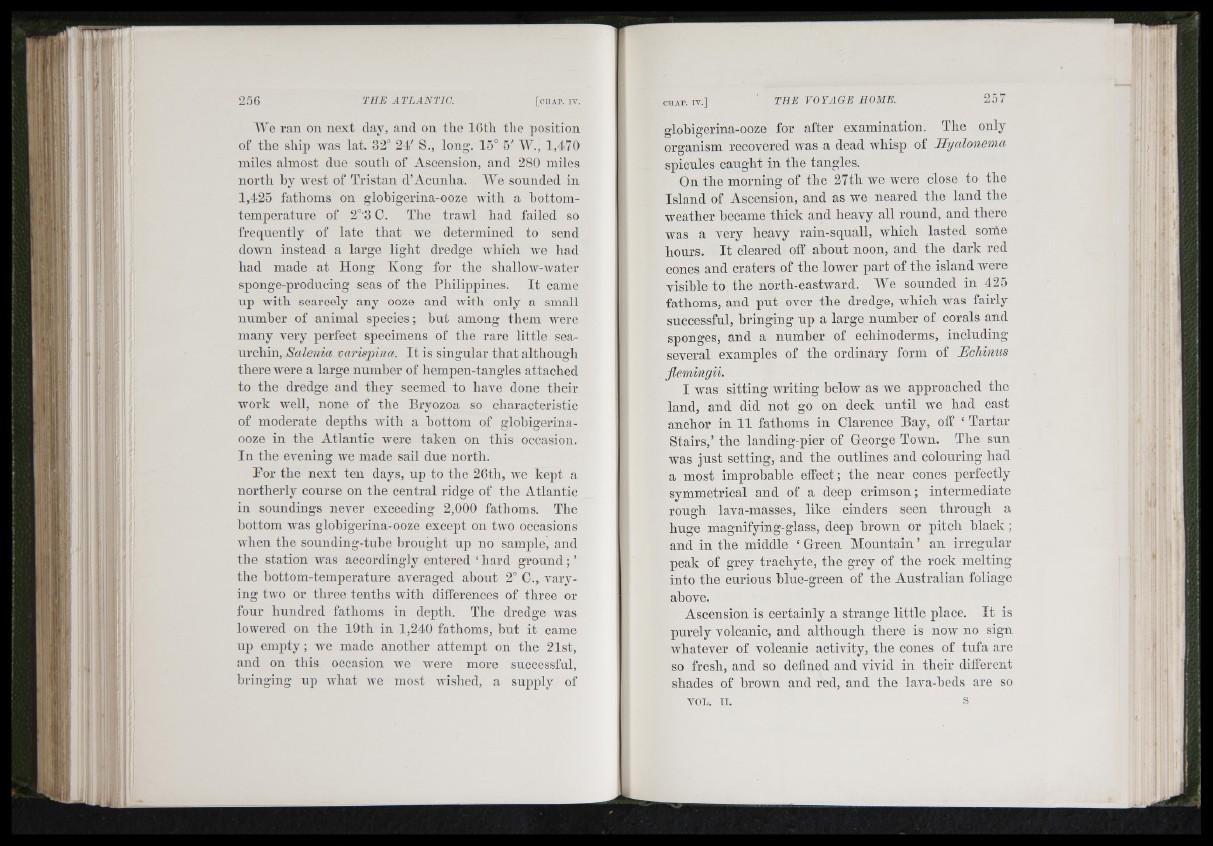
W e ran on next day, and on tlie 16th the position
of the ship Avas lat. 32° 21' S., long. 15° 5' W., 1,170
miles almost due south of Ascension, and 280 miles
north hy AA'est of Tristan d’Aciiuha. We sounded in
1,425 fathoms on globigerina-ooze Avith a hottom-
temperature of 2°'3 C. The traAA'l had failed so
frequently of late th a t aa'C determined to send
doAvn instead a large light dredge AA'hich aa'c had
had made at Hong Kong for the shalloAv-Avater
sponge-producing seas of the Philippines. I t came
up AA'ith scarcely any ooze and AA'ith only a small
number of animal species; hut among them AA'ere
many very perfect specimens of the rare little sea-
urchin, Salenia varispina. I t is singular th a t although
there Avere a large number of hempen-tangles attached
to the dredge and they seemed to have done their
AVork Avell, none of the Bryozoa so characteristic
of moderate depths Avith a hottoni of glohigerina-
ooze in the Atlantic Avere taken on this occasion.
In the evening we made sail due north.
For the next ten days, up to the 26th, Ave kept a
northerly course on the central ridge of the Atlantic
in soundings never exceeding 2,000 fathoms. The
hottom was glohigerina-ooze except on tAvo occasions
Avhen the sonnding-tuhe hrouglit up no sample, and
the station Avas accordingly entered ‘hard g ro u n d ;’
the hottom-temperature averaged ahout 2° C., varying
tAvo or three tenths with differences of three or
four hundred fathoms in depth. The dredge Avas
lowered on the 19th in 1,240 fathoms, hut it came
up empty; we made another attempt on the 21st,
and on this occasion Ave AA'ere more successful,
hringing up Avhat Ave most Avished, a supply of
glohigerina-ooze for after examination. The only
organism recovered Avas a dead whisp of Ilyalonema
spicules caught in the tangles.
On the morning of the 27th we were close to the
Island of Ascension, and as we neared the land the
weather became thick and heavy all round, and there
was a very heavy rain-squall, Avhich lasted some
hours. It cleared off about noon, and the dark red
cones and craters of the loAver part of the island Avere
visible to the north-eastward. "We sounded in 425
fathoms, and put over the dredge, Avhich was fairly
successful, hringing up a large number of corals and
sponges, and a number of echinoderms, including
several examples of the ordinary form of Feliinus
flemingii.
I was sitting Avriting helow as Ave approached the
land, and did not go on deck until we had cast
anchor in 11 fathoms in Clarence Bay, off ‘ Tartar
Stairs,’ the landing-pier of George T oavu. The sun
was just setting, and the outlines and colonring had
a most improbable effect; the near cones perfectly
symmetrical and of a deep crimson; intermediate
rough lava-masses, like cinders seen through a
huge magnifying-glass, deep hroAvn or pitch hlack ;
and in the middle ‘ Green Mountain ’ an irregular
peak of grey trachyte, the grey of the rock melting
into the curious hlue-green of the Australian foliage
ahove.
Ascension is certainly a strange little place. I t is
purely volcanic, and although there is now no sign
Avhatever of volcanic activity, the cones of tu fa are
so fresh, and so defined and vivid in their different
shades of brown and red, and the lava-heds are so
VOL. TT. s